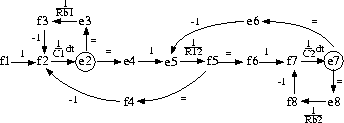The bond graph model of the physical system is used to derive a temporal causal graph which captures the dynamic characteristics of system behavior. The temporal causal graph is derived in two steps [14, 18]:
The temporal causal graph for the
bi-tank system in Fig. 4 is derived from the causally
augmented bond graph in Fig. 5 and
shown in Fig. 7.
The graphical structure
represents effort and flow variables as vertices, and relations
between the variables as directed edges.
The relations can be attributed to junctions and
system components. Junction relations add labels -1, 1,
and = to a graph edge. The = implies that the junction constrains
the two variable vertices associated with the edge to take on
equal values, 1 implies a direct proportionality and -1 implies
an inverse proportionality for the variable associated with the
two incident vertices. When the edge is associated with a
component, it represents the component's constituent
relation. For example, for a resistor with flow causality,
the edge between effort
and flow is labeled ![]() and for a capacitor
the edge is labeled
and for a capacitor
the edge is labeled ![]() .
.

Figure 7: Temporal causal graph of the bi-tank system.
Junctions (0, 1), transformers (TF, GY),
and resistors (R) introduce
magnitude relations that are instantaneous,
whereas capacitors (C) and inductors (I)
also introduce temporal effects. In general, these temporal effects
are integrating, and their associated rate of
change is determined by the path that links an observed
variable to the initial point where a deviation occurs.
Note the natural feedback mechanisms of dynamic physical systems
that result in closed paths in the temporal causal graph. Between
passive elements, these feedback mechanisms always have a negative
gain [24] and if they include an integrating
effect, as a result from a state variable in the system, these
closed paths are referred to as state loops.

An added advantage of bond graph models is that they allow automatic derivation of the steady state model of the system. In case of the bi-tank system, both the tank capacities in steady state can be replaced by flow sources with value 0, since no change of stored energy takes place. The steady state bond graph and its resulting steady state causal graph are shown in Fig. 8. Notice that the causality links in the steady state graph differ from the causality links in the dynamic behavior graph (Fig. 7) and have less meaning. Since there is no unique causal ordering, a steady state graph represents a set of algebraic equations rather than differential equations. Causality helps solve these equations, but its actual assignment is not critical. Independent of causality assignment in steady state graphs, the set of algebraic equations is invariant and equal effects of parameter deviations are generated for different causality assignments.

Figure 8: Steady state bond graph of the
bi-tank system and its corresponding causal graph.